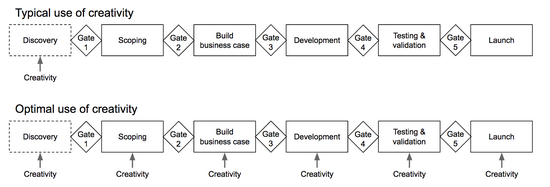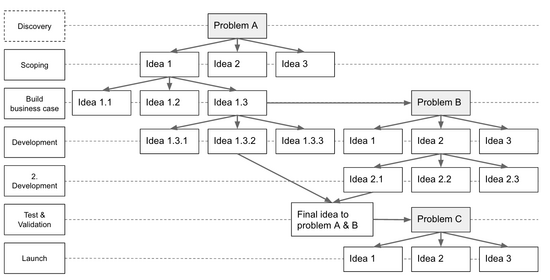Creativity as a Practice in Projects
(→Introduction) |
|||
| Line 1: | Line 1: | ||
| − | + | =Introduction= | |
Creativity is when something novel and relevant is created. It can be everything from a joke, clay model or food recipe to something more business oriented – new product, process or strategy. Notice that creativity is not only creating something new or unique, but just as important, it should be relevant and appropriate for a given problem or situation <ref>Goleman, Kaufman, and Ray, The Creative Spirit, p. 68</ref>. This last notion is what often is referred to as innovation, new ideas that bring value <ref>Innovations bog</ref>. This article focuses on the topic of creativity used in organizations, and more specifically projects, programs and portfolios. Creativity is what typically fosters the non-standard, imaginative and original solutions to a problem. It is therefore by its nature highly valued by managers and organizations, as it can solve the unsolvable problems and bring competitive advantage. | Creativity is when something novel and relevant is created. It can be everything from a joke, clay model or food recipe to something more business oriented – new product, process or strategy. Notice that creativity is not only creating something new or unique, but just as important, it should be relevant and appropriate for a given problem or situation <ref>Goleman, Kaufman, and Ray, The Creative Spirit, p. 68</ref>. This last notion is what often is referred to as innovation, new ideas that bring value <ref>Innovations bog</ref>. This article focuses on the topic of creativity used in organizations, and more specifically projects, programs and portfolios. Creativity is what typically fosters the non-standard, imaginative and original solutions to a problem. It is therefore by its nature highly valued by managers and organizations, as it can solve the unsolvable problems and bring competitive advantage. | ||
| − | ==Creativity in project, program and portfolio management | + | ==Advantages & Disadvantages== |
| + | |||
| + | =Creativity in project, program and portfolio management= | ||
[[File:Screen_Shot_2014-11-25_at_00.08.58.png|550px|thumb|right|Creativity used in different stages of a project]] | [[File:Screen_Shot_2014-11-25_at_00.08.58.png|550px|thumb|right|Creativity used in different stages of a project]] | ||
| Line 8: | Line 10: | ||
[[File:Creativityexample.png|550px|thumb|right|Example of how creativity is necessary through all project phases]] | [[File:Creativityexample.png|550px|thumb|right|Example of how creativity is necessary through all project phases]] | ||
| − | |||
| − | |||
| − | ==Project manager as facilitator | + | =Specific methods= |
| + | |||
| + | =Project manager as facilitator= | ||
| − | + | =Implementation Advice= | |
=References= | =References= | ||
<references/> | <references/> | ||
Revision as of 03:01, 25 November 2014
Contents |
Introduction
Creativity is when something novel and relevant is created. It can be everything from a joke, clay model or food recipe to something more business oriented – new product, process or strategy. Notice that creativity is not only creating something new or unique, but just as important, it should be relevant and appropriate for a given problem or situation [1]. This last notion is what often is referred to as innovation, new ideas that bring value [2]. This article focuses on the topic of creativity used in organizations, and more specifically projects, programs and portfolios. Creativity is what typically fosters the non-standard, imaginative and original solutions to a problem. It is therefore by its nature highly valued by managers and organizations, as it can solve the unsolvable problems and bring competitive advantage.
Advantages & Disadvantages
Creativity in project, program and portfolio management

